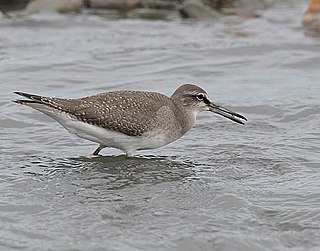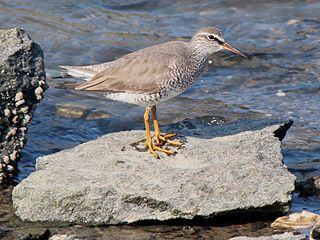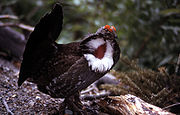
The mimids are the New World family of passerine birds, Mimidae, that includes thrashers, mockingbirds, tremblers, and the New World catbirds. As their name suggests, these birds are notable for their vocalization, especially some species' remarkable ability to mimic a wide variety of birds and other sounds heard outdoors. They are commonly referred to as mimic thrushes but are not, in fact, thrushes.

Crossbills are birds of the genus Loxia within the finch family (Fringillidae), with six species. These birds are characterized by the mandibles with crossed tips, which gives the group its English name. Adult males tend to be red or orange in color, and females green or yellow, but there is much variation.

The long-tailed duck or coween, formerly known as the oldsquaw, is a medium-sized sea duck that breeds in the tundra and taiga regions of the arctic and winters along the northern coastlines of the Atlantic and Pacific Oceans. It is the only member of the genus Clangula.

Tringa is a genus of waders, containing the shanks and tattlers. The genus name Tringa is the Neo-Latin name given to the green sandpiper by the Italian naturalist Ulisse Aldrovandi in 1599. They are mainly freshwater birds, often with brightly coloured legs as reflected in the English names of six species, as well as the specific names of two of these and the green sandpiper. They are typically associated with northern hemisphere temperate regions for breeding. Some of this group—notably the green sandpiper—nest in trees, using the old nests of other birds, usually thrushes.

The spruce grouse, also known as Canada grouse, spruce hen or fool hen, is a medium-sized grouse closely associated with the coniferous boreal forests or taiga of North America. It is the only member of the genus Canachites.

The grey-tailed tattler, also known as the Siberian tattler or Polynesian tattler, is a small shorebird in the genus Tringa. The English name for the tattlers refers to their noisy call. The genus name Tringa is the Neo-Latin name given to the green sandpiper by Aldrovandus in 1599 based on Ancient Greek trungas, a thrush-sized, white-rumped, tail-bobbing wading bird mentioned by Aristotle. The specific brevipes is from Latin brevis, "short", and pes, "foot".

Bicknell's thrush is a medium-sized thrush, at 17.5 cm (6.9 in) and 28 g (0.99 oz). One of North America's rarest and most localized songbirds, it breeds on coniferous mountain tops and disturbed habitats of northeastern North America. While very similar in appearance and vocalization to the gray-cheeked thrush, the two species, with two completely different breeding ranges, differ slightly in their morphology and vocalizations. It was named after Eugene Bicknell, an American amateur ornithologist, who made the first scientific discovery of the species on Slide Mountain in the Catskills in the late 19th century. John Burroughs, in his essay, "The Heart of the Southern Catskills" (1886), writes effusively about the voice of Bicknell's thrush heard near the summit on his climbs of Slide Mountain, and how on his stays on Slide saw them nowhere else but "about the summit", and saw no other thrush but Bicknell's.

Townsend's warbler is a small songbird of the New World warbler family.

The dusky grouse is a species of forest-dwelling grouse native to the Rocky Mountains in North America. It is closely related to the sooty grouse, and the two were previously considered a single species, the blue grouse.

The Chinese pond heron is an East Asian freshwater bird of the heron family, (Ardeidae). It is one of six species of birds known as "pond herons". It is parapatric with the Indian pond heron to the west and the Javan pond heron to the south, and these three are presumed to form a superspecies. As a group they are variously affiliated with the squacco heron or the Malagasy pond heron. As of mid-2011 there are no published molecular analyses of pond heron interrelationships and osteological data is likewise not analyzed for all relevant comparison taxa.

The tattlers are the two very similar bird species in the shorebird genus Tringa. They formerly had their own genus, Heteroscelus. The old genus name means "different leg" in Greek, referring to the leg scales that differentiate the tattlers from their close relatives, the shanks.

The Siberian grouse, also known as Siberian spruce grouse, Amur grouse, or Asian spruce grouse, is a short, rotund forest-dwelling grouse. A sedentary, non-migratory bird, it is the only member of the genus Falcipennis. The spruce grouse of North America, which physically looks similar, is now placed in the monotypic genus Canachites.

Red fox sparrow is the collective name for the most brightly colored taxa in the American sparrow genus Passerella, the Passerella iliaca iliaca group.

The sooty fox sparrow contains the darkest-colored taxa in the genus Passerella. It is currently classified as a "subspecies group" within the fox sparrow pending wider-spread acceptance of species status. It has long been suspected to be a separate evolutionary lineage due to morphological distinctness, and this is confirmed by analysis of mtDNA sequence and haplotype data. This group appears to be most closely related to the thick-billed and/or slate-colored fox sparrows.

The slate-colored fox sparrow group comprises the Rocky Mountain taxa in the genus Passerella. It is currently classified as a "subspecies group" within the fox sparrows pending a more-thorough genetic assay of all forms.

The thick-billed fox sparrow group comprises the peculiarly large-billed Sierra Nevadan taxa in the genus Passerella. It is currently classified as a "subspecies group" within the fox sparrow, pending wider-spread acceptance of its species status.

The russet nightingale-thrush is a species of bird in the family Turdidae. It is endemic to Mexico.

The sooty grouse is a species of forest-dwelling grouse native to North America's Pacific Coast Ranges. It is closely related to the dusky grouse, and the two were previously considered a single species, the blue grouse.

The saltmarsh sparrow is a small New World sparrow found in salt marshes along the Atlantic coast of the United States. At one time, this bird and the Nelson's sparrow were thought to be a single species, the sharp-tailed sparrow. Because of this, the species was briefly known as the "saltmarsh sharp-tailed sparrow." Saltmarsh sparrow numbers are declining due to habitat loss largely attributed to human activity.

The gray hawk or Mexican goshawk is a smallish raptor found in open country and forest edges. It is sometimes placed in the genus Asturina as Asturina plagiata. The species was split by the American Ornithological Society (AOU) from the gray-lined hawk. The gray hawk is found from Costa Rica north into the southwestern United States.
































